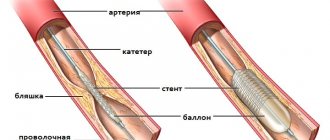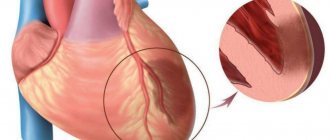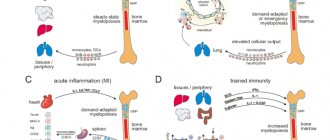Heart attacks in dogs occur in any breed and at any age. The death of part of the heart muscles, or a heart attack, is a serious pathology that causes an irreparable blow to the entire blood system and the functioning of blood vessels. Poor circulation, as well as a disturbed cardiovascular system, very often provoke serious problems. Like people, our pets also often experience this pathology.
If the owner of the animal has doubts about the health of the pet, or needs necessary medical assistance, you should immediately contact a veterinary clinic for a consultation. After a heart attack, the animal requires special care, as well as constant medical supervision. Prevention of heart disease should be carried out throughout the life of the animal.
What is a heart attack
Many people have heard about this pathology, but not everyone knows what a heart attack is. In this case, “attack” is a somewhat incorrect term, since it indicates the consequences, but not the cause. Essentially, a “heart attack” is the death of some part of the muscle tissue of the heart itself (due to a heart attack or thrombosis).
Considering how important the heart is for the body of any living creature, one should not be surprised at the severity of the consequences of its partial inoperability. It is what happens to the animal at the moment of heart rhythm failure that is called an attack. Let us note that heart attacks in dogs are quite rare, but this is due not so much to their actual rarity as to the large number of deaths and “sudden deaths.”
Pulse rate
It is most convenient to count the pulse by feeling it on the femoral artery. It is located on the inner surface of the hind limb, closer to the abdomen. Grasp the front of the animal's left hind limb with the palm of your left hand, placing your thumb on the outside and the other four fingers on the inside of the thigh. The same procedure can be done with the right hand, checking the pulse on the right hind limb. Carefully feel the pulse (pulsation of the artery) with the tips of your index, middle and ring fingers, placing them in a row. In short-haired dogs, the pulse can be found on the underside of the tail at the base.
Coherence of heart contractions and pulse.
Normally, the pulse rate is equal to the heart rate.
Color of mucous membranes and capillary refill rate.
The mucous membranes are rich in blood vessels. The color of the mucous membranes will give you an idea of the quality of their blood supply. The easiest way to assess the color of the mucous membranes is by examining the gums and the inner surface of the eyelids. In healthy dogs, the color of the mucous membrane is pale pink. For some dogs, black pigmentation on the gums and inner lips is normal. In this case, assessing blood supply is difficult. The capillary refill time is the period during which the gum mucosa (or any other mucous membrane) restores its original color after pressing on it with a finger. This effect is explained by the fact that when pressure is applied, blood is pushed out of small vessels called capillaries. Normally, the capillary refill rate is 1-2 seconds.
Body temperature. In dogs, temperature is measured rectally using an electronic or mercury thermometer.
Lubricate the end of the thermometer with Vaseline and carefully insert it into the animal's rectum approximately 2.5 cm. Assess the result after 1-3 minutes.
Normal temperature in dogs ranges from 37.8 to 39.2 C.
The main causes of a heart attack in a dog
Causes of a heart attack in a dog:
- In older dogs, tumors can grow directly into the heart muscle tissue. They not only compress normal muscle tissue, but also “take away” nutrients and oxygen from it. As a result, the death of part of the muscles and the development of an attack.
- Hyperthyroidism , i.e. dysfunction of the thyroid gland.
- Kidney problems. The adrenal glands secrete important hormones involved (including kidney problems) in regulating blood pressure. After nephritis or nephrosis, this process may be disrupted, the animal begins to suffer from hypertension, and this is fraught with serious heart pathologies.
- Infectious diseases of viral and bacterial etiology. If the pathogen gets into the blood (and this will definitely happen), it will quickly end up in the heart. The consequences of his life activity can be completely unpredictable. In particular, some infections are fraught with the development of inflammation of the walls of blood vessels (this is called vasculitis). If the vessels of the heart muscle itself are inflamed, normal trophism and oxygenation of the organ are disrupted, which threatens the development of an attack. Distemper especially often ends with a heart attack.
- Atherosclerosis. With this pathology, the inner surface of the blood vessels is covered with cholesterol plaques. Having come off, the latter can clog the lumen of blood vessels in the heart itself, which will lead to rapid tissue necrosis and cause an attack. This disease is extremely rare in dogs.
- Pathologies of the coronary arteries. As a rule, their appearance is a consequence of extremely high levels of cholesterol in the blood. In dogs, however, this disease is vanishingly rare.
- Poisoning. If the toxin is quite “vigorous” and has managed to enter the blood in sufficient quantities, the heart will feel bad.
- Acceleration of ESR, increase in blood viscosity. In this case, the blood becomes so thick (due to dehydration or intoxication, for example) that it is very difficult for the heart to pump it through the entire body. In addition, such blood flows much worse through small blood vessels, which negatively affects the trophism and oxygenation of heart tissue.
Risk group
At risk are dog breeds that have a genetic predisposition to heart disease:
- dachshunds;
- brachycephals;
- poodles;
- Yorkshire Terriers;
- Dobermans;
- boxers (especially Arrhythmogenic cardiomyopathy);
- Great Danes and other large dogs (decompensated cardiomyopathy);
- Shepherd dogs are predisposed to hemangiosarcoma.
Also at risk are older dogs and those who have suffered an infectious disease or injury.
Bitches with pyometra (purulent inflammation of the uterus) often develop bacterial endocarditis.
Age and breed characteristics
There are certain age and breed characteristics that slightly increase the risk of heart attacks in some varieties of these animals. Of course, this does not mean that representatives of certain breeds die from heart attacks, but the health of their cardiovascular system must be monitored more closely.
Heart attack in older dogs
Heart attacks are most common in older dogs because their organ systems are already worn out and do not have sufficient strength reserves. This is especially typical for elderly “giants”, i.e. dogs of large and extra large breeds.
Such animals have an impressive body size, but their heart size is not too different from that of a wolf. Because of this, the organ of such dogs works every day under enormous overload, which leads to its pathologies. The predisposing factor in this case is considered to be improper maintenance during puppyhood: when the pet’s body grows quickly, the heart cannot keep up with it. You can’t overload the puppies! The intensity of training before the age of one year should be minimal!
Seizure in small breed dogs
Seizures occur much less frequently in small breed dogs. The body size of such dogs is small, and it is much easier for their heart to pump blood throughout the body.
Therefore, they have attacks only in the presence of serious predisposing factors:
- Very poor and unbalanced feeding at an early age. This will inevitably manifest itself in the future (but not necessarily in the form of a heart attack).
- Parasitic diseases. Heartworm is especially dangerous.
- An attack in “kids” is a common consequence of previous infectious pathologies (especially viral ones).
Briefly about the main thing
- Heart failure is a disease in which the heart cannot pump enough blood, the chambers of the heart dilate, and cardiac output decreases.
- Heart failure cannot be cured; it is a lifelong diagnosis that must be monitored throughout your life.
- Heart failure develops as a result of other cardiac pathologies, both congenital and acquired. Not every heart disease entails failure, but only those that impair hemostasis.
- The disease is classified into four degrees and four indices, depending on the severity of symptoms.
- Dog breeds at risk with a predisposition to heart pathologies include: Dachshunds, poodles, Yorkshire terriers, brachycephalics, Dobermans, boxers, Great Danes and some other breeds.
- Diagnosis of the disease is possible only in a clinical setting, after examination by a specialist and special research methods (X-ray, echocardiography, ECG, ultrasound of the heart and laboratory tests).
Symptoms and first signs of a heart attack in a dog
If the owner notices any symptoms and the first signs of a heart attack in a dog, it is necessary to immediately call a veterinarian. You need to pay attention to the following:
- The dog's body temperature may rise or fall sharply.
- Vomiting is often observed (its appearance is associated with surges in blood pressure).
- All visible mucous membranes turn very pale or blue.
- The animal begins to breathe unnaturally and strangely.
- The initial stages of an attack are characterized by a sharp increase in heart rate.
- The pet becomes very lethargic and apathetic.
- You may notice a strange tilt of the dog's head.
- The animal shows painful anxiety and behaves strangely (as in the case of people, the clouding of consciousness affects it).
- After this, the stage of convulsions and seizures usually begins, but this does not last long.
- As a rule, the animal falls into a deep faint, which may well develop into a coma.
- After this, the dog either comes to his senses or dies (unfortunately, this happens more often).
Symptoms
Symptoms of heart disease in dogs have a number of specific features. Thus, pet owners who suffer from a severe cough, which occurs more often at night, turn to the veterinarian.
In addition, the pet weakens, lethargy and general apathy appear. The dog refuses to play, gets tired quickly and does not want to eat.
In the left-sided form of the pathology, the following symptoms occur:
- shortness of breath of mixed type;
- pronounced crepitus of the pulmonary structures during auscultation;
- dullness of sound in the area of the border of the lungs against the background of edematous phenomena;
- heart murmurs;
- changes in the characteristics of blood pressure, weak thread-like pulse.
Signs of right-sided heart disease are:
- dropsy or ascites of the abdominal cavity;
- severe lethargy of the pet;
- violation of the respiratory process - shortness of breath develops;
- swelling of the jugular veins;
- increase in liver size;
- weak pulse.
Find out more about the symptoms of myocardial infarction in a dog>>>
First aid for a dog at home
Let us warn you right away: first aid for a dog at home in case of a heart attack is ineffective; we recommend immediately calling a veterinarian at the first sign. It sounds trivial, but in practice nothing more useful can be done. But it's still worth a try.
- If, immediately after the development of the first symptoms, you give the dog 5 drops of cardamine or 6 to 16 drops of Corvalol (the exact amount depends on the weight of the pet), the attack can often be stopped.
- If the pet shows signs of confusion, it has convulsions, spastic twitching of the limbs and similar signs, it is necessary to speak kindly to the dog, pet it, and reassure it in every possible way.
- There is no need to run around your pet in a panic: this will not help stop the attack, but excess stress will almost certainly worsen the animal’s condition.
- But! If the dog demonstrates aggression, it is necessary to put on a muzzle before “calming measures”. During an attack, the animal has no control over itself, and therefore can bite hard!
- If your dog has breathing problems, you can give him aromatic salt to smell. There is no need to give ammonia, as it burns the mucous membranes of the nose, causing a severe chemical burn!
Important! No “heart massage” or other extreme methods. If the owner does not master these techniques perfectly, he will only break the dog’s ribs and finally finish him off!
Categories of severity of general condition
In emergency situations, there is a so-called triage of patients based on the severity of their condition. Category 1: the animal’s condition is critical; survival is possible provided immediate life-saving measures are taken; Category 2: the patient is likely to survive if help is provided within a few hours; Category 3: the injuries are minor; the patient does not need emergency assistance and may cede the right to priority care to patients in more serious condition.
Treatment regimen for a dog after a heart attack
Here is an approximate treatment plan for a dog after a heart attack:
- The first step is to prescribe adrenaline, as it stimulates cardiac activity.
- The dog must be provided with complete rest; any physical activity is excluded for at least three weeks. Starting from the second week, the dog can already be taken outside, but only for 15-20 minutes. No physical games, running after a stick/ball, etc.
- The dog is prescribed diuretics for approximately 5 days after the attack. These drugs ensure the removal of excess fluid from the body, which prevents the development of edema (including pulmonary edema).
- So-called ACE inhibitors are required. They normalize the lumen of blood vessels, including coronary ones, which feed the heart muscle itself.
- So-called cardiotonics are also needed. These medications normalize myocardial contractility, which has a positive effect on the recovery of the body.
At least once a week from the start of therapy, the dog is shown to the veterinarian for treatment correction.
Safety precautions
When providing first aid to an animal, your first priority is to ensure your own safety. A sick animal can behave unpredictably even towards a person trying to help it. Keep in mind that if you are bitten or severely scratched, you will not be able to help an animal in need. Remember: “safety is the key to success.” Do no harm!
Restrain the animal carefully. In an emergency, your goal is to provide help without causing harm. Incorrect or rough manipulations can harm the animal. Do not give any medications before consulting with your veterinarian.
Consequences of a heart attack in dogs
As you might guess, the consequences of a heart attack in dogs are extremely serious:
- Severe neurological pathologies, including epilepsy. Their development occurs if the pet’s cerebral cortex has been left without oxygen and nutrients for a long time. At first, nothing unusual is noticed about the dog, but the consequences of oxygen starvation may appear after a couple of years. Therefore, a pet who has suffered a heart attack needs to be looked after especially carefully and shown to the veterinarian more often (during the first year - at least once every two months).
- A heart attack does not go away without a trace even for the heart itself. Dead areas always remain, which are subsequently replaced by connective tissue “patches”. Because of this, the heart can no longer contract as efficiently, and the risk of developing valve pathologies and other diseases leading to heart failure increases.
- The animal cannot endure physical activity with the same vigor ; the dog no longer runs so dashingly after a stick or ball and no longer runs so willingly with its relatives.
- The risk of developing edema increases sharply. An ill dog often suffers from cold swelling of the chest, groin, and paws. They are a clear indication of heart failure, and such animals should be regularly examined by a veterinarian and prescribed supportive treatment.
Anatomy of the heart
To better understand the mechanism of the disease, you need to have minimal knowledge about the structure of the heart.
In short, a dog's heart consists of four chambers:
- right atrium;
- right ventricle;
- left atrium;
- left ventricle
The aorta emerges from the left ventricle, and the pulmonary artery emerges from the right ventricle. The pulmonary veins flow into the left atrium (there are three in dogs, and four in humans), and the superior and inferior vena cava flow into the right atrium.
The valve apparatus of the heart plays a critical role. The role of the valves is to allow blood to flow in only one direction.
On both the left and right, the atrium and ventricle are separated by a bicuspid valve or mitral valve (in humans, there is a tricuspid valve between the right atrium and ventricle).
At the entrance to the aorta and pulmonary artery there are semilunar valves that separate them from the ventricles.
Like people, dogs have 2 circles of blood circulation - large and small.
The great circle begins in the right ventricle. From it, oxygenated blood is pushed into the aorta. Through the vessels branching from the aorta, oxygen-rich blood goes to the head, limbs and abdominal organs, where gas exchange occurs.
As a result of gas exchange, blood, already poor in oxygen, but rich in carbon dioxide, enters the right atrium through the vena cava. From the atrium, blood enters the right ventricle and the pulmonary circulation begins.
Blood enriched with carbon dioxide from the right ventricle is pushed into the pulmonary artery and “goes” to the lungs, where gas exchange occurs and the blood is saturated with oxygen. Already oxygen-rich blood flows through the pulmonary veins into the left atrium, from there into the left ventricle and a large circle begins again.
Now it will be easier to understand the causes of heart failure.
Prevention measures
The following preventative measures will significantly reduce the risk:
- Balanced feeding, consistent with age, breed, physiological characteristics. The dog should not gain weight, but at the same time, his body should receive all the necessary nutrients, micro- and macroelements.
- It is necessary to normalize physical activity at an early age. The dog is growing quickly, but his heart is growing much slower in size. No need to overload it.
Transportation of the victim
The best thing you can do for a sick and, in particular, injured animal is to take it to a veterinary clinic. Give the victim maximum peace and comfort. Transport stray dogs with extreme caution. Such animals, as a rule, are not accustomed to people; when you approach, all of them, and especially the injured ones, will experience severe fear. You can use plywood or other hard material as a stretcher. Secure your dog to the stretcher using rope or duct tape. Small dogs can be transported in boxes lined with fabric.
Laryngeal paralysis
This condition is common in older dogs of large breeds (such as Labradors, golden retrievers). The essence of the disease is that the lumen of the larynx, which is located behind the pharynx and in front of the trachea, loses its ability to expand during inhalation. The larynx stops opening and the flow of air cannot penetrate the windpipe.
An early sign of the disease is a change in the timbre of barking; in some cases, the dog completely loses the ability to bark. Breathing becomes difficult and very noisy.
Laryngeal paralysis is often found in animals that experience difficulty breathing after vigorous or moderate exercise. Sometimes paralysis manifests itself more clearly when the weather changes (warming), which makes it possible to establish a diagnosis. Severe respiratory distress in overweight dogs in hot, humid weather is also typical of this disease.
It is important to exclude symptoms of rabies when such complaints occur!!! This disease is deadly for people and animals.
It is important to consider: • was the animal vaccinated against rabies no more than 12 months ago? • Has your dog been bitten by other animals for at least 2 months? • Is the animal kept in areas where rabies has occurred?
At the slightest suspicion of rabies, you must contact your local state veterinary clinic! First aid for difficulty breathing due to paralysis: • wet the dog's chest and stomach with cool or cold water; • minimize exposure to stress factors; • do not try to insert your hands or any instruments into the dog's mouth, unless you see a foreign object in the dog's throat when he breathes with an open mouth; • Take the dog to the clinic immediately.
Clinical death
The basis for performing cardiopulmonary resuscitation is the presence of obvious signs of clinical death (the so-called visible cessation of vital body functions).
The onset of clinical death is determined by one or more of the following signs: • Complete cessation of breathing • Heartbeats and pulse undetectable by palpation • Mucous membranes remain blue • Persistent loss of consciousness
There are situations when the animal’s breathing, heartbeat and pulse are present, but the patient is unconscious. If you try to perform cardiopulmonary resuscitation on him, and at that moment the animal suddenly regains consciousness, you risk serious bites!









